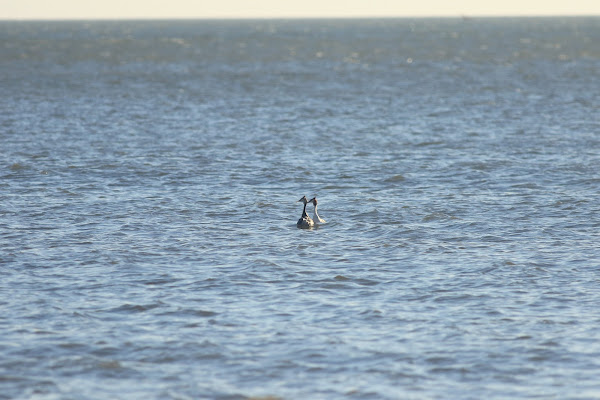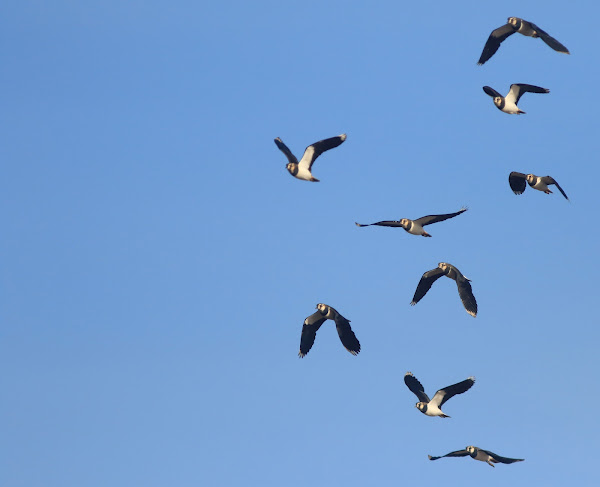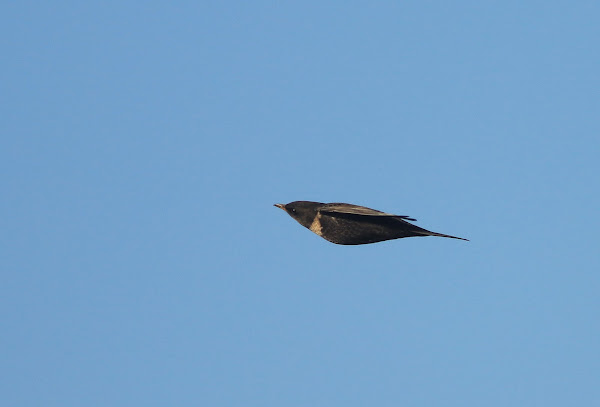Wednesday, February 23, 2022
Against The Wind
From today's Humber Surveys, on the North bank at Paull: it's too windy even for windfuckers* at the moment, hence this female applying an alternative feeding strategy and pacing around on the deck, snuffing out invert snacks.
European Golden Plovers, likewise laying low in the gales at Paull
(*Don't blame me, blame your ancestors - it is a legit archaic name for Kestrels, after all....)
Tuesday, February 22, 2022
500km (and $6k+) for Turtle Doves!
My usual running track (here in torrential February rain and strong winds), Filey Beach - ten km of sandy bay, stretching from the end of my road to the start of the chalk at Speeton. Hard to imagine life without it, running or otherwise.
Anagach Woods, Highland. A particularly memorable evening in Caledonian Pine forest: a misty, beautiful session that got even better when I randomly bumped into my friend Simon, also running - which turned into an 8k trail run, setting the world to rights in the mud after dark.
Saltburn-by-the-Sea, September - early a.m run with a killer hangover after my mum's 75th celebrations. I can still feel the throbbing temples
Eyemouth, autumn - Snow Buntings and Twite joined me for this one
Full-on, shirt-off, growling psycho mode for this 10k to Speeton Sands and back, around midnight one night back in December. It wasn't pretty, but it ate up some kilometres towards my target and improved my mood greatly, so who cares?
On the south bank of the river Humber at Killingholme. A regular location for my bird surveys, involving full estuary counts every two hours - so if and when possible, I fitted in a 5 or 6k between counts. Effectively a private running track, even better on calm, mild days, like this one in November.
Killingholme again, looking downriver - always swirling clouds of shorebirds to enjoy while plodding up and down between industrial sites.
Filey seafront - frozen beard sleet, crunchingly audible even above the podcast in my earbuds
Shetland, October - a run memorable not only for being cold, wet and very windy, but also hilly. Ouch.
Two weeks guiding at Spurn in late autumn meant dragging my sorry arse out for runs after long days in the field with clients. Here outside the Crown and Anchor after a memorable run that incorporated laps around the Warren and Kilnsea wetlands, and three owl species (Little, Barn and Short-eared) at the latter.
Wednesday, February 9, 2022
Sea of Love - displaying Great Crested Grebes, Filey
Watching unexpected behaviour is arguably as bigger buzz as birding can provide, and that of these Great Crested Grebes - in full-on display mode, out on the rolling waves of Filey Bay - falls impressively into that category.
Not actually wholly unexpected (I've watched these romantic episodes during several recent late winters here), it is, however, a counterintuitive marvel to experience. Witnessing these birds - that breed exclusively on freshwater and are associated with dramatic dancing displays involving admirably choreographed moves and lumps of weed as 'gifts', is one thing; witnessing them doing their thing offshore on saltwater (and using a feather as a present, see above), without a potential territory in sight, is quite another.
Tuesday, February 8, 2022
Killingholme Lapwings, February '22
More ongoing survey work along both banks of the Humber, and more beautiful spactacle courtesy of waders - and today is was all about the Lapwings. Sadly decreasing across their range, seasonal movements of wintering birds meant I had several thousand for company all day, and what a joy that was.
Wednesday, February 2, 2022
2021 - The Year In Nocmig: Flamborough
No fewer than three Bitterns croaked over the village recorder in the spring (library pic from Hackney, 2010)
November was similarly low-key, with a small range of species involved (mostly late season waders, thrushes and wildfowl) in generally small numbers; a year-best 404 Redwings on 2nd, regular Pink-feet and another handful of always very welcome Whooper Swan registrations were the pick of the action.
2021 was my first full year of nocturnal migration sound recording (nocmig) at Flamborough, after starting the project there in August 2020. A garden in the village was once again the recording site, and for the first few months of the year, I was using an mp3 recorder, before acquiring a (pre-programmable) Audiomoth to do the overnight work.
2020's efforts were very fruitful (see here), and I was looking forward to more comparative data and musing over both the similarities and differences with my Filey recorders, the latter running simultaneously 15km north-west (see here).
I started recording in February for a total of twelve nights, all in the latter half of the month, and returns were quite varied for the time of the year (with more movement than at Filey). Teal, Wigeon, Lapwings, Coot, Black-headed Gulls, Song Thrushes, Blackbirds and Oystercatchers all figured multiple times, with Curlew and Dunlin also clocking in, plenty of Redwings (with a peak of 47 on 18th), good movements of Pink-footed Geese on several evenings, and Whooper Swan on 24th.
Being one of the potentially most productive nocmig months, I ran the recorder every night in March, and happily, it didn't disappoint. As hoped, species variety and abundance steadily improved as the month wore on, and in addition to the species listed for February, new additions included Bar-tailed Godwits (on 4th), expected species like Grey Herons and Common Gulls and passerines including Skylark, Dunnock, Starling and Robin by mid-month; but it was several nights from 20th onwards that really produced.
The 20th was the first night of (genuine) migrant species into double figures, with a big push of Curlew, good numbers of Blackbird and Redwing, the first Snipe of the year, plus Robins, Skylark and small numbers of wildfowl - a classic early spring exodus back to Scandinavia. More the same followed on the 21st, with the year's first Knot and Common Scoters, while the 22nd continued with species into double figures and the first scarcity of the year - a Bittern over at 1935hrs....
....While the 23rd and 24th continued the fruitful theme, the latter night seeing the first big movement of Scoters - 12 flocks, some which being clearly very substantial. More followed (although to a lesser degree) through to the month's end, with a push of Golden Plovers on 29th including singing birds:
April soon began delivering, with more waders (including the first Ringed and Little Ringed Plovers), plenty of Scoters (including a big night on the 8th with eleven, often large, flocks) the first Water Rails, the first Green Sandpiper on 14th, and a Mute Swan (a local scarcity!) on 18th, the same night a chattering flock of Black-tailed Godwits migrated overhead:
All of which made for a productive month overall (considerably more productive than Filey), but the cherries on the cake were undoubtedly a further two Bitterns, on 23rd and 29th respectively. Amazingly, after the aforementioned late March record, that made three for the spring, and further rewrites the status of this species on the headland.
May was a generally more modest affair, with a respectable range of species - plenty of rallids (particularly Moorhens), a good cast of shorebirds (it being a good month for Whimbrels and Turnstones, and also Knot, Dunlin and the commoner plovers among others), the first Sandwich Terns of the year, a few more late Scoters, and a small cast of passerines (the pick being two Spotted Flycatchers) - but little in the way of stand-out nights or counts; interestingly, presumably the same Little Ringed Plover gave territorial songs overhead on the nights of 2nd and 3rd - very unexpected in the middle of a village!
As the spring migration period ebbed away into summer, so migration faded fast, with far less registrations of just single figures of species overall in June; July saw a gradual improvement as the month wore on, with small numbers of waders (although all in single figures, but for Oystercatchers), Sandwich and Common Terns and a few other expected species. August again saw low numbers of registrations, but a broadening of the species range, with Green Sandpiper and Greenshank, all three Terns (including the year's first Arctics), a flock of Common Scoters on 22nd, decent Whimbrel passage on several nights, and scarcer waders such as Sanderling, Knot and Turnstone again figuring.
As was the case at Filey through the much of the autumn, Flamborough's theme was one of relentless low pressures and strong SWs, and poor results overall. September was low-key with notables including Common and Sandwich Terns early in the month, Common Scoters on the 14th, the first Grey Plovers of the autumn on 15th, and big numbers of Pink-footed Geese on the 23rd and 24th (with very substantial skeins on both nights).
The first half of October was mostly fairly quiet but for small numbers of winter thrushes and later-season shorebirds (including Grey Plovers, Dunlins, Curlews and Redshanks), but the 13th saw 286 Redwings (the month's peak count) and lots of Pink-footed Geese incoming, the 15th had a large, noisy flock of Whooper Swans, and on the 18th, a Ring Ouzel chacked over among fluctuating thrush numbers that week. Ten skeins of Pinks (some clearly very large) yapped over on 21st, with several decent flocks over on other nights later in the month; Whoopers happily figured on a handful of other nights too.
Ring Ouzel, November (library pic from up the coast here at Filey)
An unidentified, disctinctive call from early July - we strongly suspect Cuckoo, but can't yet find a match....
So, how was it overall? As discussed in my Filey 2021 nocmig summaries, a strange one, at least compared to the previous year. Poor prevailing conditions and winds, which were seemingly neverending, especially in the autumn, were doubtless a major contributory factor, with the Sep-Nov season being particularly unproductive compared to 2020.
Whooper Swan - a pleasingly expected nocmig species in both migration seasons
However, my Flamborough site clearly performed better overall in the spring than my Filey locations, and - rarities notwithstanding - again picked up more waders among other species; and three Bitterns in that season were particularly satisfying. How will 2022 rack up against the previous two years? Stay tuned to find out.....
Subscribe to:
Posts (Atom)








































